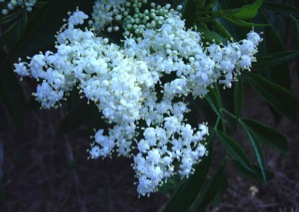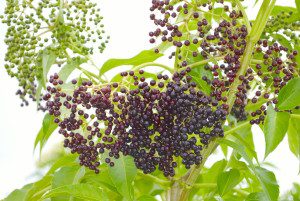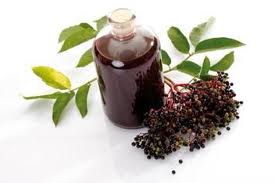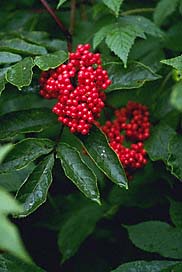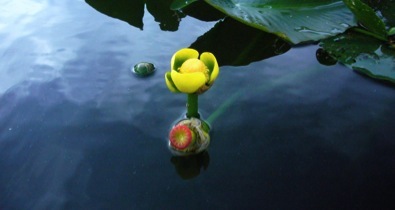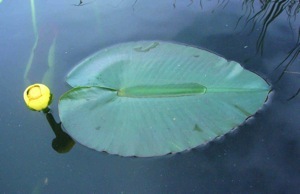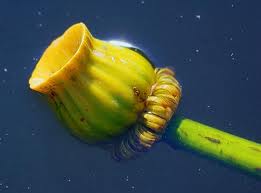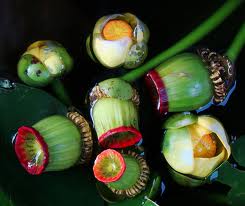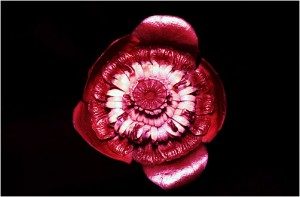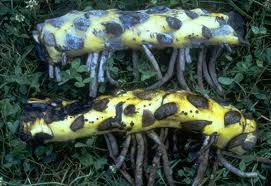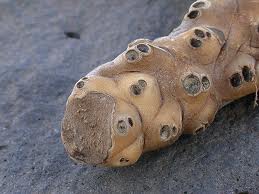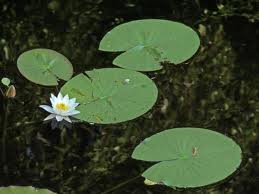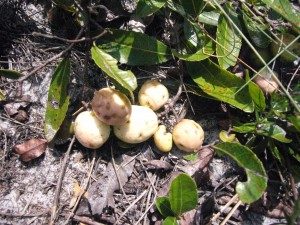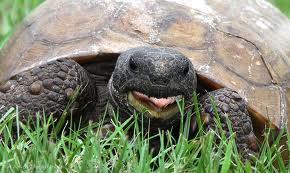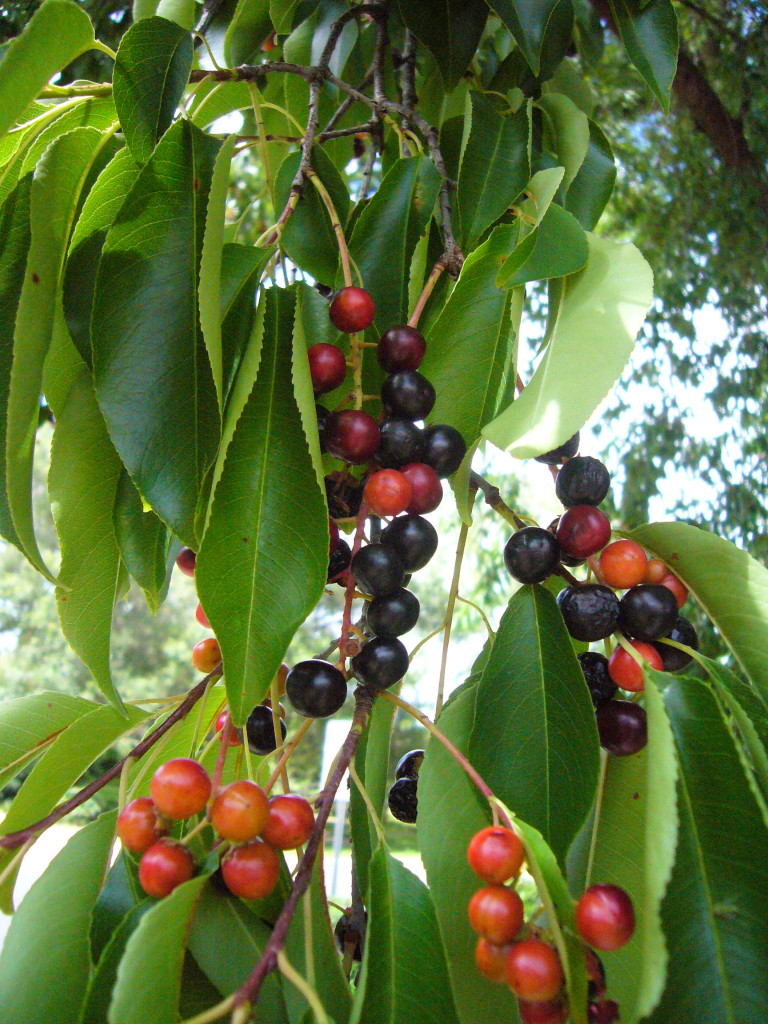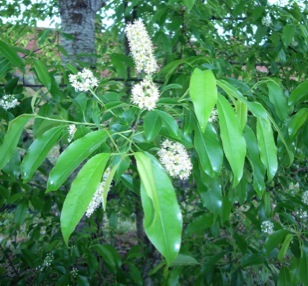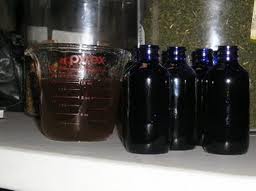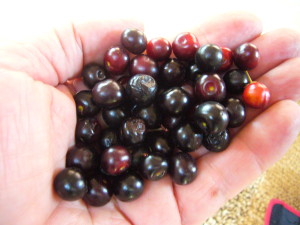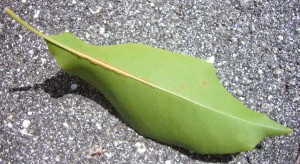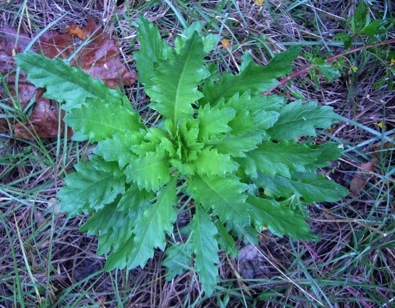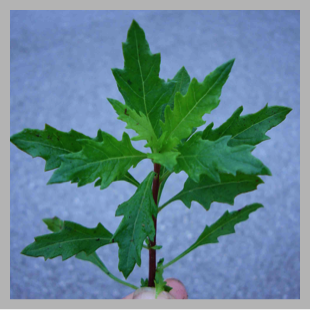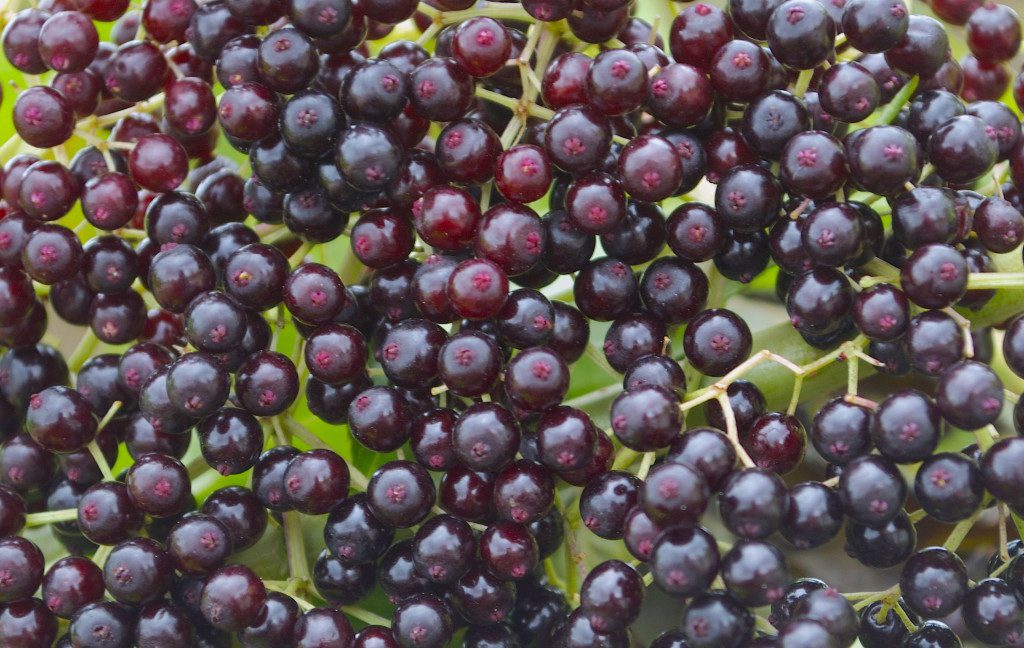
While some elderberries can be eaten raw some cannot and most improved with processing. Photo by Green Deane
Sambuca’s Fine For Elderberry Wine
Start your New Year off right with a glass of elderberry wine or elderberry blossom champagne. Don’t have any? Well, next year then.
I started mine off right: I bottled six gallons of elderberry wine, six gallons of cherry wine, and a leftover gallon of apple wine this morning. Most of the wine, but not all of it, made it into the bottles… As it should be. After all, it is New Year’s, and I am cooking a goose with wild rice stuffing (mixed with chopped pecans and tangerines right off the tree.) Alas, bachelors dine alone but well. Back to elderberries… Incidentally, I am writing now about only black or deep purple elderberries. Read about red elderberries at the bottom of the page.
Elderberries are easy to like. They’re user-friendly. Jam, jelly, pies, syrup, schnapps, brandy and wine can be made from them. The flowers are also edible and can be used in pancakes and muffins or just dipped in batter and fried. They also make a nice tea or a refreshing “Elder Blow Champagne.” Elderflower water is also used in perfumes and sweets.
Many writers say raw elderberries have an unpleasant taste. The ones in my yard do not, but that can change from location to location, shrub to shrub. Most agree that they do need to be cooked if you are going to eat more than just a few out of hand. That’s because they have a small amount of cyanide producing glycosides, which are released upon digestion, but so do loquats.
Professor Julia Morton, who was the first, middle and last word about poisonous plants in warm climates, especially Florida, says the fully ripe black berries are not toxic and you can eat as many as you like. She adds, though, that their flavor is moderated by drying. And in fact, I have a large jar of dried elderberries and sprinkle them on and in many things when cooking. Boiling or baking certainly takes care of any “toxic” issue as does drying raw berries. The Mikasukis Indians considered elderberries a scarcity food only. Incidentally, the elderberry bush sheds a lot of hollow stems that insects like to live in. Watch out for them on the plant and under your feet while picking elderberries. Oh, elderberries do not have thorns. If you think you have an elderberry and it has thorns you have a Hercules Club. Don’t eat those seeds.
As for my personal experience with black elderberries ….I don’t have a sweet tooth —which makes my Greek relatives wonder if I am adopted — but my favorite immediate use for elderberries is pies, though you have to add an acid like vinegar or lemon juice. The great thing about elderberry pie is it is seasonal and rare. You can’t buy one. It is not processed, edible non-food stuff we call food. It’s the real deal, and delicious with a texture similar to blackberry pie. If I have enough elderberries, I make wine. If in between, I make schnapps.
I might add that Dr. Morton agrees with a 14th century European comment that young elderberry shoots may be cooked like asparagus and eaten. I haven’t eaten any elderberry shoots but I have plenty in my yard. About five years ago I went to a vacant wet lot and dug up a couple of young elderberry shrubs. They have grown into a clump of them in my yard. The odd thing is they don’t live too long, just two or three years each. But, they are always sending up shoots so the clump is slowly moving as new trees grow and old trees die off. The clump is migrating at about two feet a year to the north. There is a road in its path in about 10 years: Stand by for that update.
Elderberries are nutritious, are packed with antioxidants, and have more Vitamin C than oranges or tomatoes. They also have Vitamin A, calcium, thiamine, niacin, twice the calories of cranberries and three times the protein of blueberries. They put grapes to shame, and man is not the only consumer. Over four dozen kinds of birds like elderberries as well as the occasional rodent and butterfly. Bears really like them — ripe or unripe — and deer and moose will nibble on them.
The elderberry is in the honeysuckle family and have too many medicinal uses to mention here. They are one of the mainstays of herbalism and home remedies. Where ever it grows it has been the local pharmacy. Interestingly bruised leaves in water and soap (stirred some) is a good insecticide for plants you don’t eat. By the way, its botanical name is Sambucus canadensis (sam- BEW-kus kan-uh-DEN-sis).
Sambucus comes from the Greek word “sambuke”, a musical instrument believed to heal the spirit (In Europe Elderberry wood was used for making musical instruments.) Canadensis is from Canada, or northern North American. As for Elderberry recipes, there are hundreds if not thousands of them on the internet — books in fact — and you can look them up as need be but I will give you a hint: Freeze the cluster of berries, they will separate from their branches much easier and cleaner. And to not leave you totally recipeless, here is a concoction from the 1400s:
Take elderflowers and grind them in cow’s milk, add flour, heat until it thickens.
Seems they liked their recipes short back then. If you have just a few elderberries, a pound or so, try this,
Elderberry Schnapps:
(This presumes you have already rinsed and cleaned the elderberries of all stems. Remember the freezing hint.) Weigh the elderberries then put them in a clean glass jar with a tight-fitting lid. Whatever they weighed, cover then with half that weight in unflavored vodka, or more if necessary to cover. Tighten the lid. Let them seep in a dark place one to four weeks at room temperature, shaking now and then. Strain, discard the berries, and put the liquid in new, clean glass jar with a tight fitting lid. Age at least two months.
That is not unlike Loquat Grappa (see my Loquat article.) Now, if after all of this you are still with me a December 2006 study reported in the Journal of Medicinal Foods shows the elderberries in North America to have anti-cancer and antioxidant activity.
A friend surprised me one time by confusing in conversation the poisonous water hemlock with the elderberry. Since I know both plants well I never considered that they have a passing resemblance. One becomes a shrubby tree with berries, the other is a herb with a splotchy hollow stem. But, the leaves and umbrella-shaped flowers are similar to the new eye, especially young plants. While there are many differences the easiest one to remember involves the leaves. In the water hemlock the veins in the leaves run to a notch between the leaf’s teeth. The hemlock leaf is deeply serrated and the veins are very easy to see, and they run right to the bottom of a notch between two teeth. The elderberry has much finer serrations and veins in the leaves run towards the end of the leaf, or to a tooth tip, rarely to a notch. To read more about their differences click here.
Elderberry Wine
This is for one gallon of wine. For five increase ingredients except yeast.
3 lbs ripe elderberries
2 lbs fine sugar
3 1/2 qts water
2 tsp acid blend
1 tsp yeast nutrient
1/2 tsp pectin enzyme
1 crushed Campden tablet
Montrachet wine yeast
Wash the elderberries and remove the stems while rejecting the unsuitable ones. Boil the water and stir in the sugar until it dissolves. Put the berries in a nylon straining bag, tie it and place it in the first container. Mash the elderberries while wearing sterilized rubber gloves. Pour the boiling sugar water over them and cover. When this mixture has cooled to a lukewarm temperature, add the acid blend, crushed Campden tablet and yeast nutrient. Cover the primary container and wait for 12 hours. Stir in the pectin enzyme, cover the primary container once again and wait another 12 hours before adding the yeast. Stir daily for 14 days and gently squeeze the bag while wearing sterile gloves, re-covering the container each time. Drip drain the elderberries without squeezing and add this juice to the primary container. Rack the wine into a second container and fit an airlock. Store in a dark place and ferment for two months. Rack the wine again, top up and refit the airlock. Repeat this step two more times. Stabilize the wine and wait for 10 days. Rack the wine again, sweeten to taste and pour into bottles. Store the containers in a dark place for one year.
Red Elderberries
Some references say red elderberries are edible, some say they are not. Bradford Angier, a well-known Canada-based forager, said eating a lot of raw, whole, red elderberries gave him “digestive upsets.” Angier lived off the land for years at a time, so he is a man of practical information. Research does clarify this and says deseeded ripe, cooked red elderberries are edible. In Volume 30, Issue 6, of the June 2003 issue of the Journal of Archaeological Science, red elderberries are discussed. It says:
“In this article, we examine the use of red elderberry fruit at site 35-TI-1, a late Holocene village on the northern Oregon coast, where more than 68,000 seeds from this fruit have been recovered. Despite the fruit and its seeds being somewhat toxic, red elderberry was widely used both ethnographically and during earlier periods. Its ease of harvest, nutritional value compared to other fruits, and the need to remove its toxic seeds prior to consumption result in red elderberry being well represented in the region’s paleoethnobotanical record. Also, toxins in the seeds may inhibit their decomposition, allowing uncharred seeds to survive for several hundred years.”
Other researchers into “first people” diet also show they ate a lot of red elderberries — to the point of it being a staple —but removed the seeds. In another scholarly article for the Canadian Journal of Archaeology, vol. 28, 2004, pp. 254-280, it says:
Processing [red elder] berries follow[ed] operational steps including de-seeding, de-stemming, and mashing to a paste that was then eaten as a food, dried into cakes, or mixed with oil for storage (Grumet 1975: 299). Seeds of red elderberry have high levels of toxic cyanide producing glycosides and were removed after cooking or during consumption (Pojar and Mackinnon 1994: 70; Losey et al. 2003: 696, 701; Turner 1995: 14).
Three other authors say the Indians processed out the seeds before eating the cooked fruit, or spit the seeds out AND drank water to rinse the seeds out of their mouth AND drank more water than usual if they swallowed seeds. They also did not eat red elderberry “cakes” in the morning saying it created stomach ache. They waited until midday or later to eat them. And, if they ate non-ripe and or raw red elderberries they ate salmon afterwards, believing that prevented stomach aches. If this is all accurate, it suggests that ripe, cooked, seedless red elderberries are edible. The seeds contain cyanide-producing glycosides which in the gut change to hydrogen cyanide. This can cause upset stomach, diarrhea and vomiting. In large doses it can be lethal. You are on your own now, proceed with caution. Find a local expert through the Native Plant Society and ask about your local red elderberries.
Now, as if that is not enough know there is a “white” elderberry found in Australia. Its berries are white to yellow and unlike nearly all white berries they are edible. Botanically it is Sambucus (sam-BYOO-kus) gaudichaudiana (go-dih-shaw-dee-AY-nuh)
Oh….You can also make a pesticide from elderberry leaves. Boil half a quart of water and add about eight ounces of Elder leaves. Simmer the mixture for 30 minutes. Take another half a quart of warm water and mix with one tablespoon of castile soap or what soap you may have handy. Combine the soap water and the elder water and strain through a fine mesh or cloth. Use in a sprayer. It helps with attack from aphids, carrot fly, peach tree borers, and cucumber beetles. It can also be used against mildew and blackspot disease
Green Deane’s “Itemized” Plant Profile
IDENTIFICATION: Shrub to small tree, woody stem, fIve lobed flowers in clusters, white, five stamen, leaves pinnately compound, five to nine, toothed, opposite. Berries round, 1/8 of an inch, glossy, black.
TIME OF YEAR: Can blossom and fruit throughout the year in Florida but favors the spring and early summer.
ENVIRONMENT: Roadsides, thickets, damp areas, low hammocks, marshes, canal banks.
METHOD OF PREPARATION: When fully ripe black fruit can be eaten raw or cooked but go light on the raw ones. Drying berries moderates their flavor. See the warning above on red berries.
Elderberry leaves can be put in hot water with soap (be stirred) and then used as an insectide on plants.

